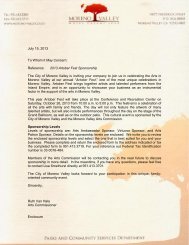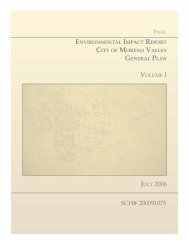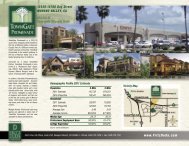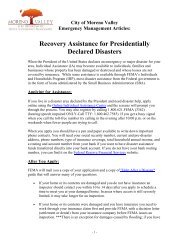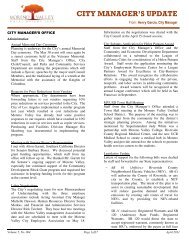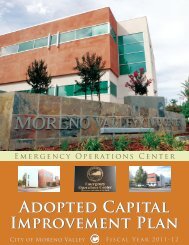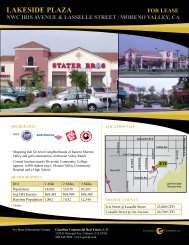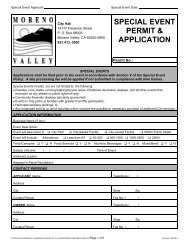2011 Comprehensive Annual Financial Report - City of Moreno Valley
2011 Comprehensive Annual Financial Report - City of Moreno Valley
2011 Comprehensive Annual Financial Report - City of Moreno Valley
Create successful ePaper yourself
Turn your PDF publications into a flip-book with our unique Google optimized e-Paper software.
The government-wide financial statements include the <strong>City</strong> and its component units. The <strong>City</strong>’s component units<br />
are the Community Redevelopment Agency <strong>of</strong> the <strong>City</strong> <strong>of</strong> <strong>Moreno</strong> <strong>Valley</strong>, <strong>Moreno</strong> <strong>Valley</strong> Community Services<br />
District, <strong>Moreno</strong> <strong>Valley</strong> Public Financing Authority, and the <strong>Moreno</strong> <strong>Valley</strong> Public Facilities Financing<br />
Corporation. Although legally separate, for all practical purposes these entities function as departments <strong>of</strong> the<br />
<strong>City</strong> and therefore have been blended as part <strong>of</strong> the primary government.<br />
Fund financial statements. A fund is a grouping <strong>of</strong> related accounts that is used to maintain control over<br />
resources that have been segregated for specific activities or objectives. The <strong>City</strong>, like other state and local<br />
governments, uses fund accounting to ensure and demonstrate compliance with finance-related legal<br />
requirements. All <strong>of</strong> the funds <strong>of</strong> the <strong>City</strong> can be divided into three categories: governmental, proprietary and<br />
fiduciary.<br />
Governmental funds. Governmental funds are used to account for the same functions reported as governmental<br />
activities in the government-wide financial statements. However, unlike the government-wide financial<br />
statements, government fund financial statements focus on near-term inflows and outflows <strong>of</strong> spendable resources<br />
as well as on balances <strong>of</strong> spendable resources available at the end <strong>of</strong> the fiscal year.<br />
Because the focus <strong>of</strong> governmental funds is narrower than that <strong>of</strong> the government-wide financial statements, it is<br />
useful to compare the information presented for governmental funds with similar information presented for<br />
governmental activities in the government-wide financial statements. By doing so, readers may better understand<br />
the long-term impact <strong>of</strong> the government’s near-term financing decisions. Both the governmental funds balance<br />
sheet and the governmental funds statement <strong>of</strong> revenues, expenditures and changes in fund balances provide a<br />
reconciliation to facilitate this comparison between governmental funds and governmental activities.<br />
Information regarding governmental funds is presented separately in the governmental funds balance sheet and in<br />
the governmental funds statement <strong>of</strong> revenues, expenditures and changes in fund balances for the General Fund;<br />
Community Services District Zones, and Development Impact Fees Special Revenue Funds; the Redevelopment<br />
Agency Capital Projects Funds; and the Redevelopment Agency Debt Service Funds. All <strong>of</strong> these are considered<br />
to be major funds. Data from the other governmental funds are combined into a single, aggregated presentation.<br />
Individual fund data for each <strong>of</strong> these non-major governmental funds is provided in the supplementary section <strong>of</strong><br />
the report in the form <strong>of</strong> combining statements.<br />
The <strong>City</strong> adopts an annual appropriated budget for its general fund. A budgetary comparison statement has been<br />
provided to demonstrate compliance with the budget.<br />
Proprietary funds. The <strong>City</strong> maintains two different types <strong>of</strong> proprietary funds--enterprise and internal service<br />
funds. Enterprise funds are used to report the same functions presented as business-type activities in the<br />
government-wide financial statements. The <strong>City</strong> uses an enterprise fund to account for its Electric Utility.<br />
Internal service funds are an accounting device used to accumulate and allocate costs internally among the <strong>City</strong>’s<br />
various functions. The <strong>City</strong> uses internal service funds to account for self-insured insurance programs, central<br />
services, technology services, facilities maintenance, equipment maintenance, and equipment replacement.<br />
Because these services predominantly benefit governmental rather than business-type functions, they have been<br />
included within governmental activities in the government-wide financial statements.<br />
Proprietary funds provide the same type <strong>of</strong> information as the government-wide financial statements, only in more<br />
detail. The Electric Utility, the <strong>City</strong>’s only enterprise fund, is included in the Basic <strong>Financial</strong> Statements. All<br />
internal service funds are combined into a single, aggregated presentation in the proprietary funds financial<br />
statements. Individual fund data for the internal service funds is provided in the form <strong>of</strong> combining statements in<br />
the supplementary section <strong>of</strong> the report.<br />
4



